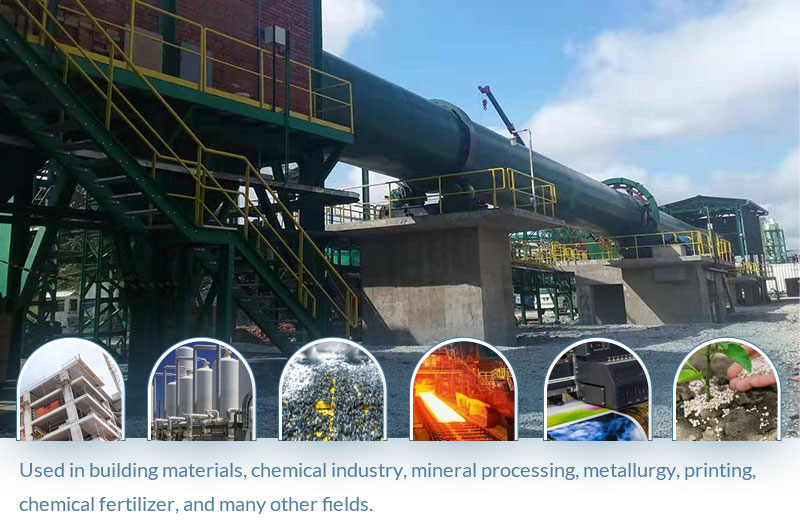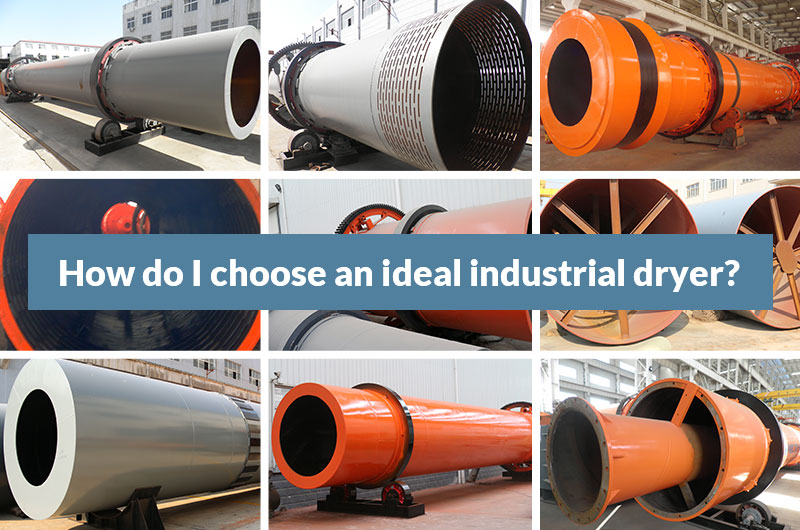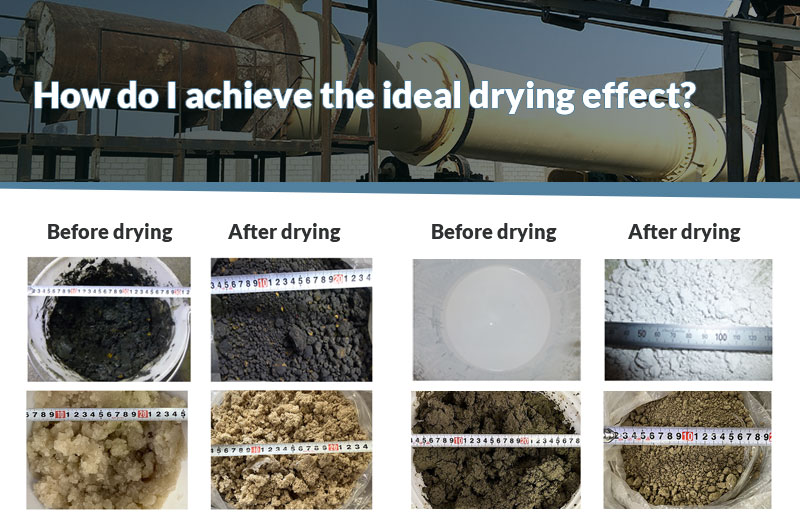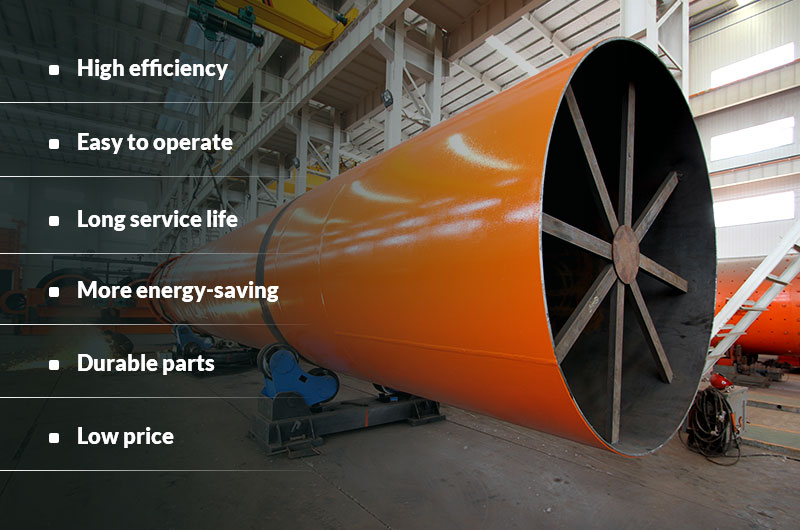If you are not engaged in manufacturing, it is easy to underestimate the key role of industrial dryers. In the construction market, the industrial dryer is an important investment project.
Industrial dryers, also known as "drying machines", are used to dry materials containing moisture. The dried materials are used in building materials, chemical industry, mineral processing, metallurgy, printing, chemical fertilizer, and many other fields.

Practical industrial dryer types
There are many types of industrial dryers available in the mining market. The most widely used drying equipment is the rotary dryer, also known as the rotary drum dryer. The following is a more detailed classification:
Industrial dryer
Dryers by heat transfer mode
-
Direct heat transfer dryer:
High-temperature gas is in direct contact with materials in the cylinder, which is more applicable. -
Indirect heat transfer dryer:
The heat required for drying is indirectly transferred to wet materials from the cylinder wall, which is suitable for small quantities.
Dryers by structure
-
Single drum dryer:
A cylinder is used as the drying body. The equipment is simple and adaptable. Lower price and less investment cost. -
Double drum dryer:
Composed of two cylinders with different diameters. The thermal efficiency is higher than that of the single drum dryer, and the energy-saving effect is more significant. -
Three drum dryer:
Composed of three coaxial horizontal cylinders inside and outside. Small footprint, 50% less than the single-cylinder dryer. The drying output is high, with the advantage of three-layer insulation. However, the structure is complex and the maintenance is difficult.
Dryers by material
-
River sand dryer:
For silica sand, river sand, sea sand, fracturing sand, etc. -
Clay dryer:
For kaolin, bentonite, bauxite, diatomite, active clay, etc. -
Lignite dryer:
For slime, anthracite, lignite, activated carbon, charcoal, etc. -
Sawdust dryer:
For sawdust, wood chips, shavings, and all kinds of straw. -
Gypsum dryer:
For gypsum, gypsum powder, and limestone. -
Slag dryer:
For slag, alkaline slag, acid slag, and mineral powder.
Customize A Dryer to Meet My Drying Line
How do I choose an ideal industrial dryer?
There are many specifications and models of industrial dryers. How can I choose the right one among many drying machines?

1. Drying materials
When selecting the dryer, it is necessary to understand the pertinence and adaptability of processing materials. Clarify the specific parameters of the materials to be dried, such as material state, thermal sensitivity, fluidity, corrosiveness, flammability, and other specific requirements.
For example, when drying ore powder, use a rotary drum dryer; when drying anthracite, use a coal dryer; when drying wood chips, use a sawdust dryer.
2. Output requirements
The capacity of industrial dryers is one of the important criteria for choosing. Customers need to combine production requirements and final output, ensuring that the machine capacity is slightly higher than the requirements. If the dryer model is too small, it is easy to be blocked. If the dryer model is too large, it will waste energy and fuel when running.
The smallest model of our dryers is 1.9-2.4 t/h, and the largest model is 60-76 t/h. Among them, the output of the three-cylinder dryer is larger, and its small model can reach 20-30 t/h.
3. Moisture content
Moisture content affects the drying rate. Materials should be checked before drying to ensure that there is no large amount of moisture or excess impurities in the materials so that they will be faster when drying!
The moisture requirements of common drying materials are: Limestone is less than 1%; clay raw materials are less than 1.5%; iron raw materials less than 2%; slag less than 2%; coal is less than 1-2%. After drying with industrial dryers, the materials can reach below 1-0.5%.
4. Energy conditions
When choosing a dryer, also consider the local energy situation and make full use of local resources. For example, in areas with more coal, the coal is used as the dryer for fuel; in areas with strict environmental protection policies, fuel or natural gas is used as the heat source.
5. Construction site
The installation location of the equipment is different, and there are different requirements for the model and installation of the dryers. Users should fully understand the working environment and site scale of the construction, and combine the size of drying equipment to make them coordinated. Otherwise, it may cause site residue or the dryer is too large to install.
6. Cost-effective equipment
The last is the balance of price and quality of industrial dryers. Comparing the cost-effectiveness of the dryer, starting from price and quality, so that the selected drying equipment is conducive to production investment.
Ftmmachinery suggests that it is best to do drying experiments on materials before selecting models to deeply understand the characteristics and states of materials.
How do I achieve the ideal drying effect?
To achieve the ideal drying effect, users must master the correct operating technology, which prolongs the service life of the dryer.

1. Startup preparation
Test run the machine before working on it. The dryer needs a preheating process, and it should not be burnt violently, to avoid damaging the equipment. When preheating, turn on the dryer to rotate, to avoid uneven heat and causing the cylinder to bend.
2. Grasp the initial moisture of materials
Although the dryer's function is to dry materials, materials with a particularly large water content should be dehydrated before drying. This can not only improve the processing efficiency of materials but also avoid the loss of the machine.
3. Control material supply
The feeding amount should be controlled for each drying to ensure that the dryer paddles can rotate to dry the materials. Too many materials fed at one time make it difficult to dry, and even cause the dryer to fail to dry normally.
4. Stable feeding
Industrial dryers mainly depend on the full contact between the materials and the heat carrier, and drying is realized using heat exchange. Whether it is the dried material or the burning fuel, it should be fed smoothly and evenly, and the feeding ratio should not be changed suddenly.
5. Master the drying time
Drying time is a very important factor. The length of drying time should be adjusted according to the situation, to achieve the best effect of drying. Too long drying time will cause excessive drying; too short drying time will result in incomplete drying.
6. Turn off the engine
When preparing to shut down, first reduce the fuel addition of the hot blast stove, and then stop the equipment feeding. After the materials in the dryer cylinder are dried and discharged, finally turn off the motor to stop the barrel from running.
Ftmmachinery improves the performance of dryers
In recent years, the world has advocated low-carbon production, and the manufacturing requirements for drying equipment have become higher. Ftmmachinery engineers introduce international innovative technology and continuously improve the performance advantages of dryers.

- High efficiency: High drying efficiency, fast speed, and good quality.
- Easy to operate: Automatic system design, temperature control device, and simple operation process.
- Long service life: Adopt high-temperature resistant materials with few faults, reducing maintenance costs.
- More energy-saving: Equipped with a reasonable air duct, the heat utilization rate is high and the fuel consumption is low.
- Durable parts: The wear-resistant alloy is used, which is 3-4 times more wear-resistant than ordinary steel plates. Replacement costs are reduced by 30%.
- Low price: The manufacturer integrates production, sales and after-sales. The dryer is about 3%-10% cheaper than other manufacturers.

